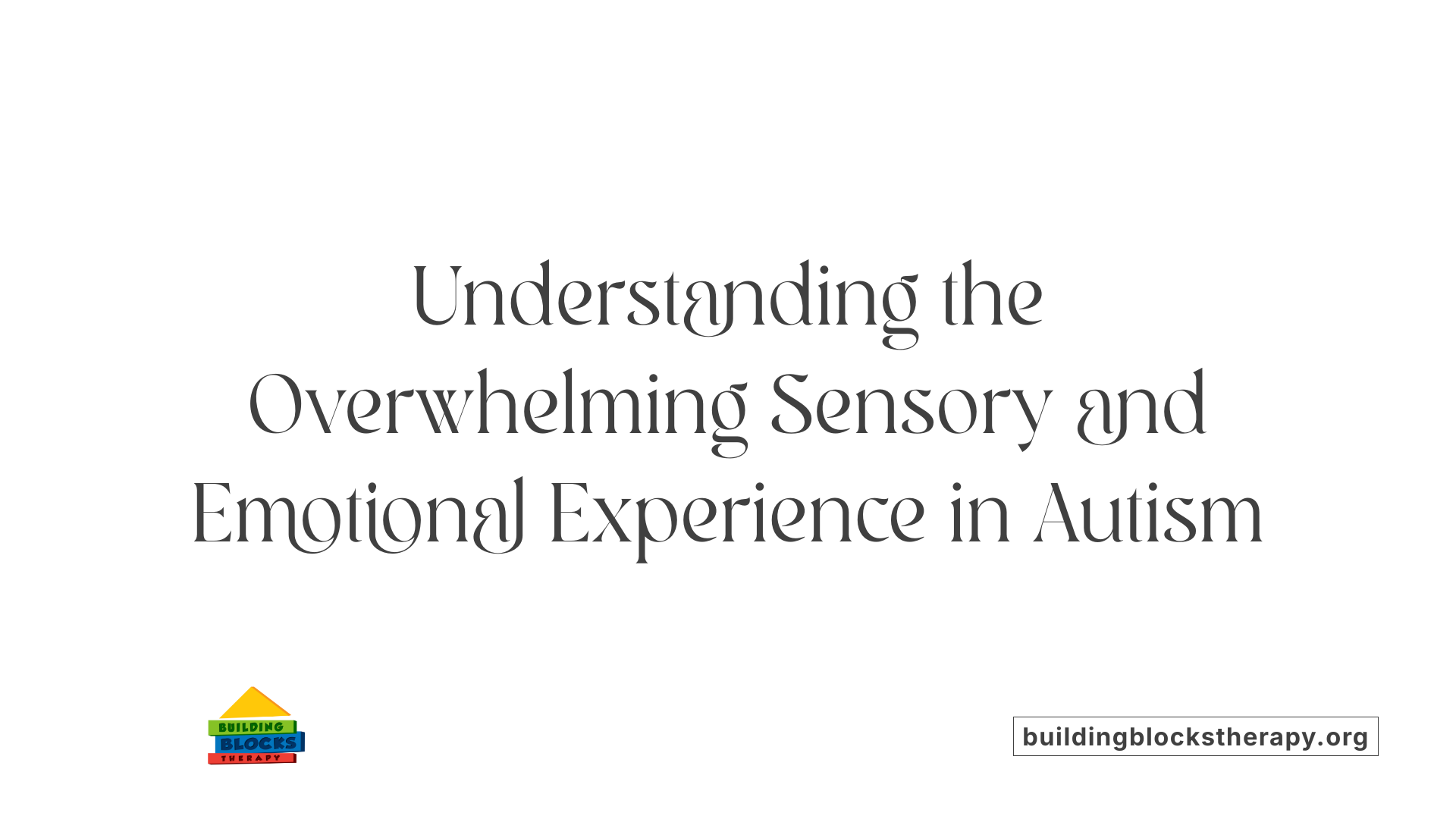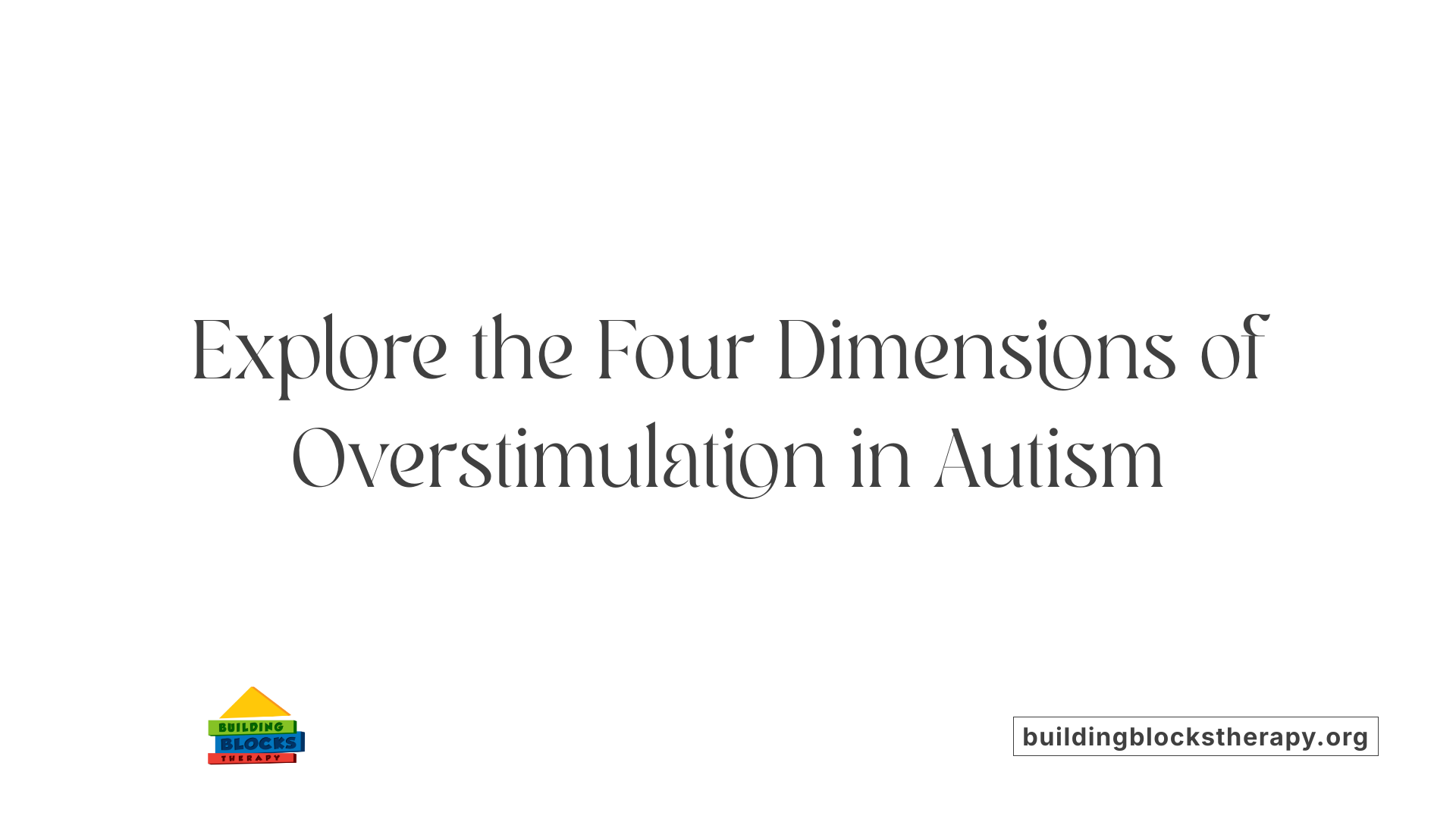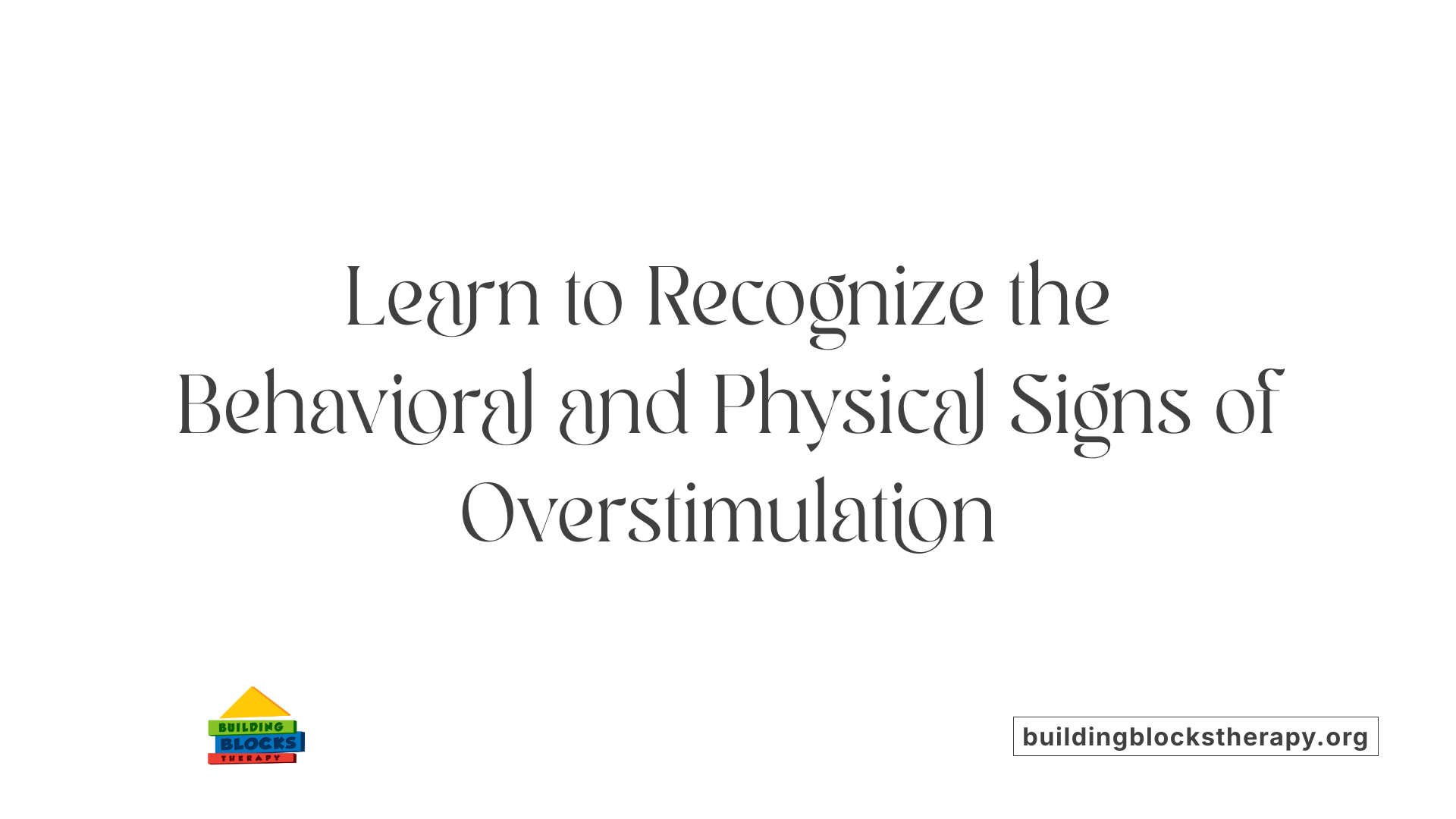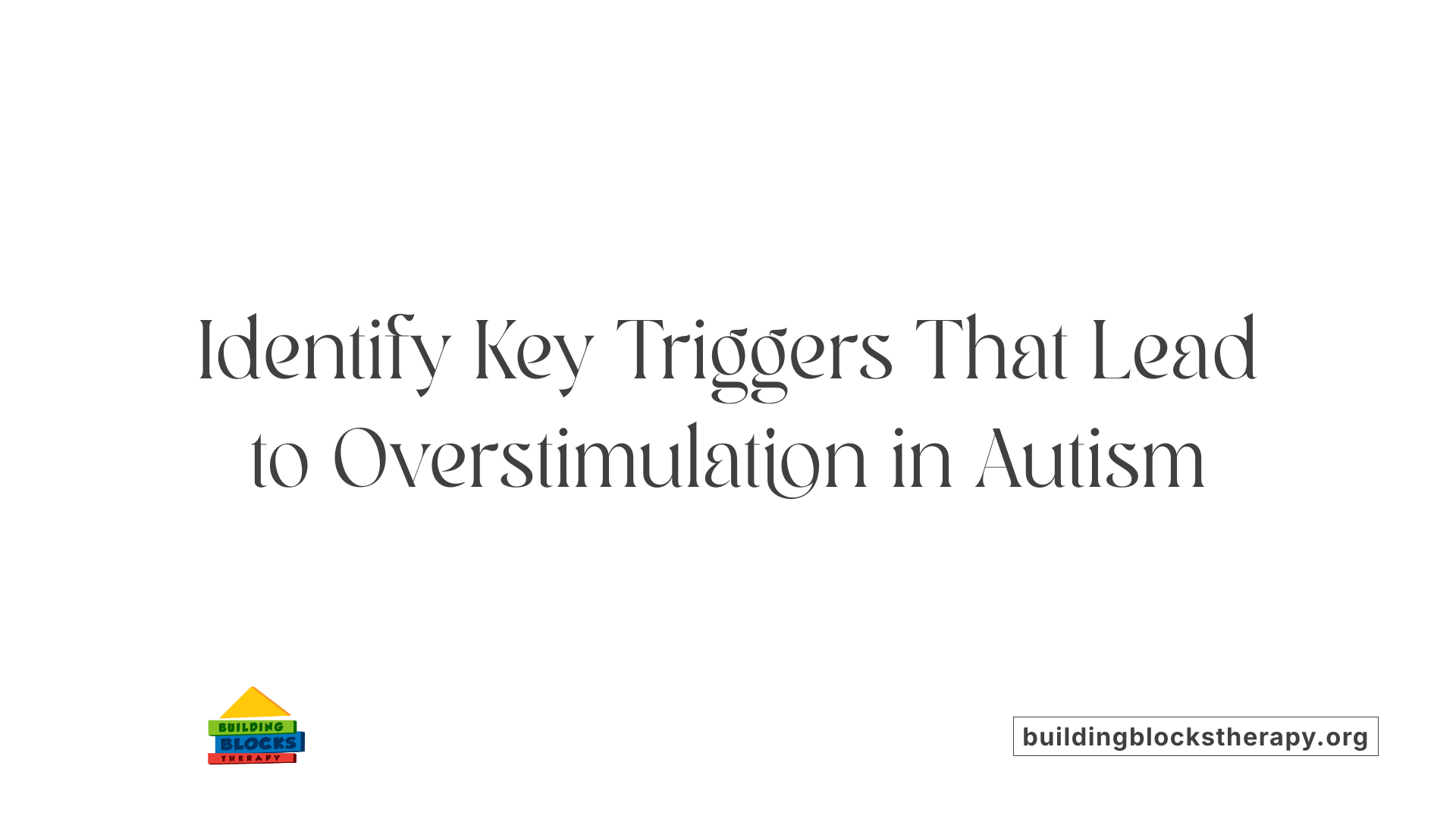Unraveling the Experience of Overstimulation in Autism
Overstimulation is a common challenge faced by many individuals with autism. It occurs when sensory inputs overwhelm the brain’s processing capacity, leading to a range of physical, emotional, and behavioral responses. This article delves into what overstimulation feels like in autism, explores its signs, causes, and triggers, and offers strategies to manage and prevent it effectively.
What Does Overstimulation Feel Like in Autism?

Sensory perceptions and physical sensations
In individuals with autism, overstimulation manifests as an intense flood of sensory input that the brain struggles to process. This can include hypersensitivity to sights, sounds, smells, tastes, or textures. For example, bright lights or loud noises might become unbearable, leading to physical sensations such as headaches, racing heart, muscle tension, or feeling hot and uncomfortable. Many autistic people report a feeling as if their head is 'fuzzy' or swirling with too much information. Physical symptoms like nausea, shivering, or difficulty breathing can also occur, making the environment feel overwhelming.
Emotional and mental state during overstimulation
Emotionally, overstimulation often triggers feelings of fear, anxiety, irritability, or anger. The mental state becomes overloaded, which can impair focus and cause emotional outbursts or meltdowns. Many experience a sense of emotional flooding, where feelings become difficult to contain. This heightened emotional response is sometimes linked to decreased connectivity between different parts of the brain, such as the limbic system and prefrontal cortex, making it hard to regulate feelings. As a result, the person might feel a need to escape or be alone to recover.
Behavioral responses and outward signs
Outwardly, signs of overstimulation include covering one’s ears or eyes, withdrawing from social situations, or exhibiting self-stimulatory behaviors like hand-flapping or rocking. Vocalizations, crying, or lashing out may also be observed. Some individuals may become restless, move erratically, or attempt to escape the sensory-rich environment. Recognizing these signs early allows caregivers and loved ones to support the individual by creating a calm space, reducing sensory input, and providing comfort.
| Perception/Feeling | Physical Reactions | Behavioral Indicators |
|---|---|---|
| Overwhelm from bright lights, loud sounds | Headache, racing heart, nausea | Covering eyes, covering ears, withdrawing |
| Hyper-awareness of textures and smells | Feeling hot, discomfort | Restlessness, pacing, avoidance |
| Intense emotions like fear or irritability | Muscle tension, sweating | Crying, meltdowns, self-soothing actions |
Managing overstimulation involves quick adjustments to the environment, using calming strategies such as sensory tools, and offering reassurance. Understanding these sensations helps in better supporting autistic individuals when they experience sensory overload.
The Four Faces of Overstimulation: Sensory, Emotional, Intellectual, and Social

What are the four faces of overstimulation?
Overstimulation is a complex experience that manifests in different ways depending on the source and type of input. It can be categorized into four main types: sensory, emotional, intellectual, and social.
Sensory overstimulation occurs when the senses are overwhelmed by sights, sounds, smells, tastes, or tactile sensations. For example, bright lights, loud noises, or itchy clothing can trigger this form of overload. Symptoms include irritability, the need to cover the eyes or ears, physical discomfort like headaches, or feelings of being on edge.
Emotional overstimulation happens when an individual absorbs intense emotions—either their own or those of others. It often results in overwhelming feelings that can lead to outbursts or irritability. This type of overload is linked to decreased connectivity between brain areas responsible for emotional regulation, such as the limbic system and prefrontal cortex.
Intellectual overstimulation involves the difficulty in focusing or prioritizing information, often due to weak central coherence or poor executive functioning. Individuals might find themselves sinking into irrelevant details or feeling overwhelmed by complex or rapidly changing information, which hampers their ability to process effectively.
Social overstimulation results from the challenge of processing multiple signals at once during social interactions. It includes interpreting verbal cues, nonverbal gestures, facial expressions, and sensory inputs simultaneously. Feelings of breathlessness, confusion, or shutdown are common signs, especially in busy or unpredictable environments.
Understanding these four facets helps in recognizing the diverse ways overstimulation can impact individuals, particularly those with autism, PTSD, or sensory processing disorders. Managing these types involves tailored strategies such as creating sensory-friendly spaces, planning social activities carefully, and using calming techniques. Awareness of the specific face of overstimulation experienced can guide better support and intervention, enhancing comfort and coping.
| Type of Overstimulation | Triggers | Typical Signs | Management Strategies |
|---|---|---|---|
| Sensory | Bright lights, loud sounds, strong smells | Headaches, covering eyes or ears, irritability | Sensory tools, environment adjustments, calming routines |
| Emotional | Absorbing others’ emotions, stress | Outbursts, crying, irritability | Emotional regulation, quiet time, therapy |
| Intellectual | Overload of information, complex tasks | Confusion, sinking into irrelevant details | Structured routines, breaking tasks into smaller steps |
| Social | Multiple social cues, noisy environments | Feeling overwhelmed, shutdowns | Planned social interactions, sensory breaks, supportive communication |
Fostering understanding of these dimensions can help caregivers, educators, and individuals themselves to identify and cope with overstimulation more effectively.
Signs and Symptoms of Overstimulation in Autistic People
 Autistic individuals often experience overstimulation when the influx of sensory input exceeds their processing capacity. Recognizing the signs and symptoms can be crucial for providing timely support to prevent escalation.
Autistic individuals often experience overstimulation when the influx of sensory input exceeds their processing capacity. Recognizing the signs and symptoms can be crucial for providing timely support to prevent escalation.
Behavioral cues are among the most noticeable indicators. Many autistic people display increased sensory seeking behaviors such as hand rubbing, spinning, or blowing bubbles, which may serve as self-regulation mechanisms. Conversely, distress signals like covering their eyes or ears, crying, or becoming irritable are common. These behaviors reveal their attempt to block out overwhelming stimuli.
Emotional reactions can include heightened anxiety, frustration, or anger, often leading to emotional outbursts or meltdowns. During these episodes, individuals might exhibit heightened levels of stimming or become very talkative as a way to manage their feelings. Some may also withdraw completely, shutting down to avoid further sensory input.
Physical signs include tense or rigid body postures, sudden jumping or crashing into nearby objects, and increased muscle tension. These reactions are signs of their body responding physically to overwhelming stimuli.
Recognizing these early cues is essential. Autistic individuals may become less responsive, less interactive, or they might act aggressively or show irritability when overstimulated. Overall, these signs serve as signals that they need immediate sensory relief.
Providing sensory breaks, calming activities, and creating a quiet, soothing environment can help alleviate their discomfort. Using tools like noise-canceling headphones, weighted blankets, or sensory toys, along with clear and calm communication, can make a significant difference in managing overstimulation.
Understanding these signs encourages caregivers and supporters to respond empathetically and promptly, helping autistic individuals regain calm and prevent further distress.
Common Triggers and Causes of Overstimulation in Autism

What are the causes and triggers of overstimulation in autistic individuals?
Overstimulation in autistic individuals often results from an overload of sensory inputs that their brains find difficult to process comfortably. Common triggers include loud noises such as sirens or parties, bright or flashing lights, strong or unpleasant smells, and textures that feel uncomfortable to touch. These stimuli can easily overwhelm the senses, especially in busy or unpredictable environments like crowded shopping centers or social gatherings.
Sensory sensitivities play a major role. Some autistic people are hypersensitive to certain stimuli, reacting intensely even to mild sensations, while others may be hyposensitive, seeking more intense input to feel regulated. Both situations can lead to feelings of overload if the stimuli become too intense or prolonged.
Environmental factors are also significant. Unfamiliar settings or sudden changes can increase stress and difficulty processing sensory information, making overload more likely. Complex or noisy environments, visual clutter, and unpredictable social interactions further elevate this risk.
Additionally, sensory processing disorder—common among autistic individuals—disrupts the brain’s ability to filter and interpret sensory signals effectively. This inefficiency means that even typical sensory input might be perceived as overwhelming.
Recognizing these triggers is crucial for managing overstimulation. Strategies like creating sensory-friendly spaces, using calming sensory tools, and planning activities to avoid overload can help autistic individuals handle their environments better. Implementing sensory regulation techniques—such as deep pressure or scheduled breaks—also helps mitigate overstimulation and supports emotional and physical well-being.
Impact of Overstimulation on Autistic Adults and Women
How does overstimulation impact autistic adults and women?
Overstimulation can have a profound effect on autistic adults and women, both emotionally and physically. Many experience a strong sense of being overwhelmed, feeling anxious, and having an intense desire to escape the source of stimuli. Unlike children who might react outwardly with crying or tantrums, adults and women may internalize their stress, showing signs such as fatigue, difficulty concentrating, or emotional withdrawal.
Sensory triggers like loud noises, bright lights, or strong smells often spark this overload due to the higher likelihood of sensory sensitivities. For autistic individuals, hypersensitivity to sensory input can make everyday environments feel overwhelming, leading to discomfort and distress. Emotional stimulation, such as complex social interactions or intense feelings, can add to this burden.
Managing these episodes usually requires flexible strategies like adjusting environments, communicating needs clearly, or taking breaks. However, if left unmanaged, overstimulation can lead to long-term exhaustion, burnout, and increased emotional struggles. Recognizing these signs early and employing personalized coping methods can significantly improve quality of life.
Long-term consequences
When overstimulation occurs frequently or persists over time, it may contribute to a cycle of burnout and emotional instability. This can reduce overall resilience, leading to heightened anxiety or depression. Additionally, chronic overstimulation might impair daily functioning, complicate social and occupational activities, and increase reliance on support systems.
Understanding the subtle signs of overstimulation in adults and women is crucial. With proper management and self-awareness, individuals can prevent escalation into more severe emotional or physical health issues, promoting better mental well-being and autonomy.
Recognizing Physical and Emotional Signs of Overstimulation
What does overstimulation feel like in individuals with autism?
For autistic individuals, overstimulation often manifests as an overwhelming flood of sensory input that exceeds their processing capacity. This intense experience can cause a combination of physical discomfort and emotional distress. Physically, they may feel their head becomes 'fuzzy' or swirling, accompanied by symptoms like headaches, increased heart rate, sweating, muscle tension, nausea, shakiness, or feeling hot and uncomfortable.
Emotionally, feelings of anxiety, fear, irritability, and anger can intensify, often leading to emotional outbursts or meltdowns. The environment may feel chaotic, and their senses become hyper-sensitive, making even common stimuli like bright lights, loud noises, or strong smells intolerable.
Recognizing these signs early is crucial. Common behavioral indicators include covering the ears or eyes, trying to escape or hide, withdrawing from social interactions, or exhibits of frustration through crying, lashing out, or self-stimulatory behaviors like humming or hand-flapping.
Understanding these physical and emotional cues allows caregivers and supporters to respond promptly. Creating a calming environment, providing sensory tools like headphones or a weighted blanket, and giving space for recovery can significantly ease the discomfort caused by overstimulation. Awareness and timely intervention foster a sense of safety and help autistic individuals regain composure more effectively.
In summary, overstimulation in autism feels like an overwhelming overload of senses and emotions, with identifiable physical reactions and behavioral signs that, when acknowledged, can guide effective support and management.
Strategies for Managing and Preventing Overstimulation
What strategies can help manage or prevent overstimulation in autism?
Managing overstimulation effectively involves a combination of environmental adjustments, sensory tools, calming techniques, and clear communication. These strategies are designed to reduce the overall sensory input and help individuals regain a sense of calm and control.
Creating sensory-friendly environments is a foundational step. This can include reducing loud noises, dimming bright lights, and minimizing overwhelming smells or textures. Setting up designated calming spaces equipped with sensory tools such as fidget toys, weighted blankets, soft lighting, and noise-canceling headphones provides a safe haven during overwhelming moments.
Calming techniques like deep breathing exercises, massage, applying gentle pressure, or performing isometric exercises can help individuals self-regulate when they start feeling overstimulated. These methods activate the parasympathetic nervous system, promoting relaxation.
Using visual supports, such as picture schedules or social stories, helps prepare individuals for upcoming activities, reducing anxiety and unexpected surprises that may trigger overload. Sensory self-care kits, customized with favorite calming items, serve as portable resources that can be used anytime feelings of overstimulation begin.
Communication also plays a crucial role. Simple strategies, like teaching the
Supporting Someone Through Overstimulation
How can I recognize if my autistic child or loved one is overstimulated?
Recognizing overstimulation in autistic individuals involves paying close attention to their behaviors and physical cues. Common signs include covering their eyes or ears, drooping or flapping limbs, increased irritability, withdrawal from social interaction, or physical symptoms such as muscle tension and rapid breathing.
They might display repetitive actions like hand-flapping, jumping, or pacing, which are often self-soothing behaviors. Sometimes, an overwhelmed person may become non-responsive, cry, scream, or act out due to their sensory overload.
Understanding your loved one's specific cues and triggers is essential, as signs can vary individually. Some may become visibly anxious, while others might seek solitude or exhibit increased self-stimulatory behaviors.
Creating a sensory-friendly environment can help prevent overstimulation. Simple modifications like reducing noise, dimming lights, and removing visual clutter make a significant difference.
When you observe these signs, offering a calm and quiet space for them to de-stress is crucial. Reassuring your loved one with a gentle voice and space to regulate can help restore their sense of safety.
Using visual schedules or timers to prepare them for changes and providing sensory tools like noise-cancelling headphones or textured objects can also support their self-regulation. Patience and understanding are fundamental during these times, as overstimulation can be distressing but manageable with appropriate strategies.
The Role of Environment and Routine in Overstimulation Prevention
How can creating sensory-friendly spaces help prevent overstimulation?
Designing sensory-friendly environments is a vital strategy to help individuals, especially those with autism, manage overstimulation. Such spaces minimize overwhelming stimuli by controlling lighting, noise levels, and textures. For instance, using soft lighting, soundproofing, and calming colors creates a soothing atmosphere.
Adding sensory tools like weighted blankets, fidget toys, or noise-canceling headphones can also provide comfort and stability. These adaptations help individuals avoid or recover from sensory overload, reducing the likelihood of meltdowns or shutdowns.
Why are structured routines important in preventing overstimulation?
Structured routines add predictability to daily life, which helps reduce anxiety and unexpected triggers. When activities are planned and transitions are communicated clearly, individuals can more easily prepare mentally for changes.
Establishing consistent schedules and routines establishes a sense of safety and control. This stability can prevent sudden surprises that might overwhelm the senses and mind.
How do environmental adjustments and routines work together?
Combining sensory-friendly spaces with structured routines creates a supportive environment that addresses both physical comfort and emotional security. For example, a daily routine might include scheduled breaks in a designated calming space, allowing time to regroup.
Practical tips for implementing these strategies include:
- Creating designated quiet zones at home or school.
- Using visual schedules to outline daily activities.
- Incorporating regular sensory breaks.
- Adjusting lighting and sound levels based on individual sensitivities.
- Planning activities that match the person’s tolerance levels.
By these means, caregivers and individuals can proactively reduce the chances of overstimulation and make daily experiences more manageable and comfortable.
Understanding and Clarifying Misconceptions About Overstimulation in Autism
Overstimulation is often misunderstood, especially in the context of autism. A common myth is that overstimulation is simply being 'difficult' or overly sensitive; however, it is a real sensory processing challenge where the brain receives more input than it can handle. This overload can cause physical distress, emotional outbursts, or shutdowns.
Many people believe overstimulation is just about noise or bright lights, but it can also stem from strong smells, textures, or social demands. Accurate understanding shows that autistic individuals may experience these stimuli more intensely and have trouble filtering or coping with them.
Another misconception is that overstimulation can be fixed with medication. Currently, there is no specific medical treatment for overstimulation itself. Instead, managing it relies on environmental adjustments, communication, and coping strategies such as sensory tools and calming techniques.
Clarifying these ideas helps foster more patience and support for autistic individuals. Recognizing overstimulation as a genuine neurological experience encourages empathy and tailored support to reduce distress and improve quality of life.
Empowering Better Understanding and Support
Understanding what overstimulation feels like in autism is crucial for providing appropriate support and creating environments where autistic individuals can thrive. Recognizing the signs early, understanding triggers, and employing effective management strategies can greatly reduce distress and promote well-being. Awareness and education are key to dispelling myths and fostering a more compassionate and supportive society for autistic people facing sensory challenges.
References
- Four Faces of Overstimulation - Autism Spectrum News
- Autism Overstimulation And Sensory Overload - Simply Psychology
- What Does Overstimulation Feel Like? A Look at the Facts Behind ...
- Overstimulation in Autism: Why it Happens & How to Respond
- Sensory overload: Symptoms, causes, and treatment
- Overstimulation in autism: What it feels like and how to recover - Rula
- How to Manage Overstimulation in Autistic Adults - Prosper Health
- Sensory issues - Autism Speaks
- What is sensory overload? What you need to know
- Overstimulation in Autism: Why it Happens & How to Respond






